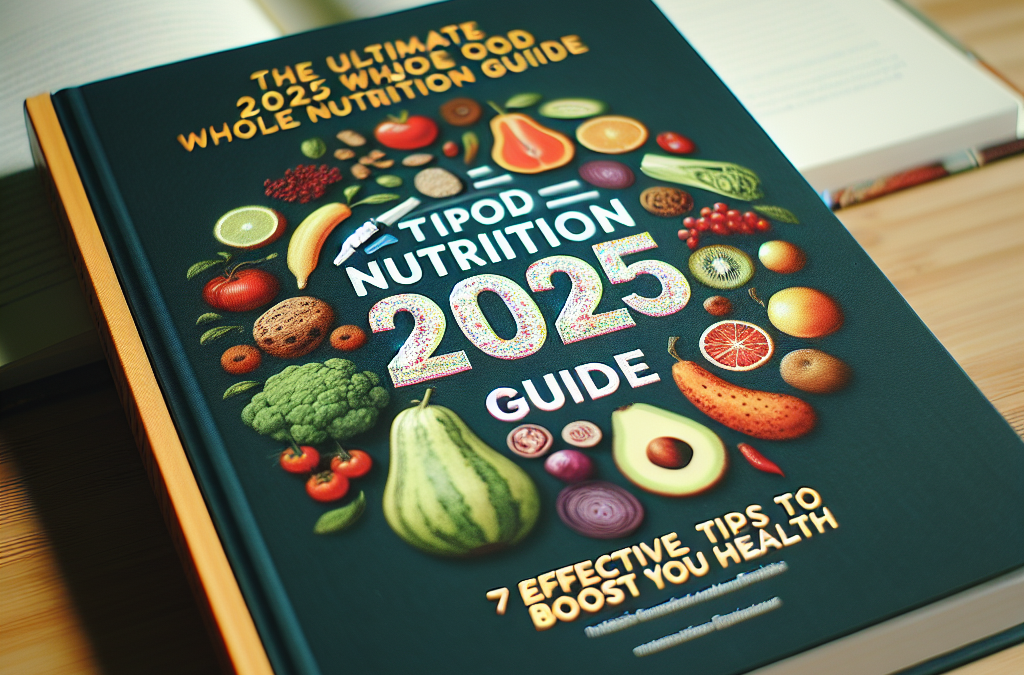Table of Contents
- 1. Modern Whole Food Principles
- 2. Choosing Organic Over Conventional
- 3. Seasonal and Local Eating
- 4. Incorporating Plant-Based Proteins
- 5. Balanced Meal Planning
- 6. Mindful Eating Practices
- 7. Supplementing with Whole Foods
- FAQs
1. Modern Whole Food Principles
Understanding Whole Food Fundamentals
In 2025, the foundation of a strong whole food nutrition guide remains rooted in minimally processed, nutrient-dense foods. Think fresh vegetables, fruits, nuts, seeds, lean meats, and whole grains. These foods retain their natural vitamins, minerals, and fiber, which are essential for optimal health. As we’ve learned over the years, emphasizing whole foods over highly processed options can significantly reduce the risk of chronic diseases like diabetes and heart disease.
When choosing foods, focus on their natural state. For example, opt for whole wheat bread instead of white bread, and choose fresh berries rather than processed fruit snacks. Such choices help your body receive the complete profile of nutrients intended by nature. This approach aligns perfectly with the core of the whole food nutrition guide that aims to cultivate health through real, unprocessed foods.
Growing research in 2025 emphasizes that a whole food-based diet not only provides more nutrients but also improves gut health, supports immune function, and promotes better energy levels. This knowledge guides many health-conscious individuals to prioritize whole foods in their daily routines.
Detoxing Myths and Realities
Many people associate detoxes with cleanses or extreme diets, but in the context of a whole food nutrition guide, detoxing is about inviting more natural, unprocessed foods into your diet. Instead of restrictive juice cleanses, focus on increasing intake of vegetables, fruits, and whole grains that support your body’s natural detoxification processes. In 2025, evidence shows that consistent, balanced eating habits outperform short-term detox diets.
Adding fiber-rich foods like chia seeds, oats, and leafy greens aids your body’s ability to eliminate toxins naturally. These foods support your liver and digestive system, which are vital for detoxification. Remember, sustainable habits built around whole foods are more effective than temporary detox trends.
By integrating whole foods into your diet, you naturally enhance your body’s ability to detox and rebuild, creating a healthier, more resilient you.
2. Choosing Organic Over Conventional
The Benefits of Organic Whole Foods
In 2025, the organic movement continues to grow, supported by scientific evidence that organic foods often contain fewer pesticides and higher levels of certain antioxidants. When considering a whole food nutrition guide, prioritizing organic options can help reduce exposure to harmful chemicals and support sustainable farming practices.
For instance, organic berries and leafy greens tend to have higher antioxidant content, which combats oxidative stress and inflammation. This can translate into improved overall health and longevity. While the cost may be higher, investing in organic whole foods is a strategic choice for long-term health benefits.
Many health experts suggest starting with the “Dirty Dozen,” a list of produce with higher pesticide residues, and choosing organic for these items. Incorporating organic whole foods into your diet aligns with your goal to maximize nutrient intake and minimize toxins.
Economic and Environmental Impact
Choosing organic isn’t just about personal health; it also impacts the environment positively. Organic farming practices promote soil health, biodiversity, and reduce pollution. In 2025, more consumers are making mindful purchasing decisions that support ecological balance.
This shift encourages farmers to adopt sustainable methods, ultimately creating a healthier ecosystem. Economically, supporting organic farms can help foster local economies and promote transparent food systems. This aligns with a broader whole food nutrition guide that emphasizes not just individual well-being but planetary health.
By integrating organic whole foods into your diet, you support a cycle that benefits your health and the environment, making your nutrition choices more impactful.
3. Seasonal and Local Eating
Advantages of Eating Seasonally
Eating seasonal foods in 2025 offers numerous health benefits and ensures your diet remains vibrant and diverse. Seasonal produce is often fresher, more flavorful, and retains more nutrients since it doesn’t spend long periods in transit or storage. Incorporating a variety of seasonal vegetables and fruits into your whole food nutrition guide helps prevent dietary monotony.
For example, in spring, fresh asparagus and strawberries are abundant; in winter, hearty root vegetables and citrus fruits take center stage. This variety not only delights your palate but also broadens your nutrient intake, supporting overall health.
Using seasonal produce aligns with sustainable eating practices, reducing the carbon footprint associated with food transportation. It encourages local purchasing, which supports regional farmers and fosters community resilience.
Shopping Tips for Local Markets
To fully embrace seasonal and local eating, visit farmers’ markets, community-supported agriculture (CSA) programs, and local co-ops. These venues often offer fresher, more nutrient-dense foods at competitive prices. Building relationships with local growers can also give you access to unique varieties not found in supermarkets.
When shopping, look for signs of freshnessâbright colors, firm textures, and minimal blemishes. Don’t hesitate to ask farmers about how and when the produce was harvested. This knowledge empowers you in following your whole food nutrition guide more effectively.
Incorporating local, seasonal produce into your diet in 2025 supports your health and strengthens your community’s food systems.
4. Incorporating Plant-Based Proteins
Top Plant Sources for Protein
In 2025, a robust whole food nutrition guide includes a focus on plant-based proteins like lentils, chickpeas, quinoa, tofu, and tempeh. These foods provide essential amino acids without the saturated fats associated with some animal products. Integrating these into your meals contributes to cardiovascular health and weight management.
For example, a bowl of quinoa salad with mixed vegetables and chickpeas is not only delicious but also packed with complete plant-based protein. Such meals support muscle repair, hormone production, and immune function. Incorporating variety ensures you get a complete amino acid profile.
Research indicates that diets emphasizing plant proteins reduce the risk of chronic diseases and support environmental sustainability. In 2025, more people are shifting toward plant-centered diets, aligning with the principles of a healthy whole food nutrition guide.
Tips for Meal Planning with Plant Proteins
Start by planning meals that include at least one plant protein source. Batch-cooking lentils or chickpeas allows for quick meal assembly during busy weekdays. Combine these with whole grains and vegetables for a complete, balanced dish.
Experiment with new recipesâtry adding edamame to salads or blending beans into smoothies. Remember, variety is key to covering all nutritional bases and keeping your meals interesting.
Mentally, shifting your perspective to see plant proteins as versatile and satisfying can motivate consistent inclusion, adhering to your whole food nutrition guide this year and beyond.
Get an Amazing Discount on the Best Certified Organic Whole Food Supplement!
5. Balanced Meal Planning
Creating Nutrient-Dense Meals
In 2025, a central aspect of the whole food nutrition guide is crafting meals that are balanced and nutrient-dense. Aim for a plate that includes a source of lean protein, healthy fats, high-fiber vegetables, and whole grains. This combination maximizes nutrient intake and stabilizes blood sugar levels.
For example, a meal might be grilled salmon with quinoa, roasted broccoli, and a drizzle of olive oil. Such a meal covers essential macronutrients and provides a spectrum of micronutrients vital for maintaining health and energy.
Understanding portion sizes and pairing foods strategically can prevent overeating and support digestion. Utilizing tools like meal prep guides and balanced plate diagrams can help you stay on track with your whole food nutrition guide.
Meal Prep and Habit Formation
Meal prepping is an effective way to ensure adherence to your dietary goals. Prepare ingredients or entire meals in advance, emphasizing whole foods, and store them for quick access. This reduces reliance on processed snacks when you’re short on time.
Incorporate seasonal produce and local ingredients into your prep. Keep healthy snacks like nuts, fruit, or roasted chickpeas handy to curb cravings. Consistent habits built around balanced, whole food meals are key to long-term health.
Remember, consistency is more impactful than perfection. Your focus should be on making sustainable choices that support your long-term well-being within the framework of a comprehensive whole food nutrition guide.
6. Mindful Eating Practices
Developing Awareness at Meal Times
Practicing mindful eating in 2025 enhances digestion and helps you connect with your body’s hunger cues. Take time to savor each bite, chew thoroughly, and appreciate the flavors and textures of whole foods. This approach can prevent overeating and improve nutrient absorption.
Setting aside distraction-free time for meals fosters a deeper connection to your food. Avoid screens and focus solely on your eating experience. This increased awareness supports your goals outlined in the whole food nutrition guide by helping you make conscious, healthful choices.
Over time, mindful eating can transform your relationship with food, turning meals into nourishing rituals rather than mindless routines. It supports digestion, satisfaction, and emotional well-being.
Mindfulness Techniques for Better Choices
Techniques such as paying attention to hunger and fullness cues, practicing gratitude for your food, and slowing down while eating can all enhance your mindfulness. Journaling your food intake can also increase awareness of your eating habits.
In 2025, incorporating mindfulness into your daily routine is a proven method to enhance the benefits of a whole food diet. It encourages you to listen to your body’s needs and choose foods that truly nourish you.
These practices reinforce the principles of a comprehensive whole food nutrition guide by fostering sustainable, intentional eating habits.
7. Supplementing with Whole Foods
Natural Supplements and Superfoods
While the cornerstone of any good whole food nutrition guide is real, unprocessed foods, supplements like spirulina, chlorella, and acai berries can provide concentrated nutrients. In 2025, superfoods continue gaining popularity for their ability to support immune function, energy, and detoxification.
Incorporate superfoods into smoothies, salads, or snacks. For example, adding a teaspoon of spirulina powder to your morning smoothie boosts your intake of iron, protein, and antioxidants. These whole-food-based supplements are a convenient way to fill nutrient gaps.
Always prioritize sourcing high-quality, pure products to ensure you’re getting the full benefits. Remember, supplements are just an addition, not a substitute for the diversity of whole foods in your diet.
Role of Functional Foods
Functional foods like fermented vegetables, kefir, and bone broth support gut health and improve nutrient absorption. These foods enhance your microbiome, which is crucial for overall health. Including fermented foods aligns with the principles of the whole food nutrition guide to foster a balanced, resilient body.
Incorporate small servings dailyâsuch as probiotic-rich yogurt or sauerkrautâto reap their benefits. In 2025, research highlights the importance of a healthy microbiome for mental clarity, immune strength, and digestion.
By thoughtfully including whole, functional foods in your diet, you reinforce your commitment to a comprehensive, health-promoting whole food nutrition guide.
FAQs
Q1: What is the best way to start a whole food nutrition guide in 2025?
Begin by assessing your current diet and gradually incorporating more fresh, unprocessed foods. Focus on shopping seasonal and local produce, choosing organic when possible, and planning balanced meals. Small, consistent changes lead to sustainable habits.
Q2: How can I ensure I get enough nutrients from a whole food diet?
Diversify your intake of fruits, vegetables, whole grains, nuts, seeds, and plant-based proteins. Use meal planning and prep strategies to maintain variety and balance. Consider consulting a nutritionist for personalized guidance.
Q3: Why is a whole food nutrition guide important for health?
Whole foods provide vital nutrients in their natural forms, supporting overall health and reducing disease risk. An emphasis on whole foods aligns with current research and trends in 2025 for a healthier lifestyle.
Q4: Can I supplement my diet with superfoods or functional foods?
Yes, in moderation. Incorporating nutrient-dense superfoods and fermented products complements your whole food diet by boosting immune health and gut function. Always choose high-quality sources to maximize benefits.
Conclusion
In 2025, following a well-rounded whole food nutrition guide remains one of the most effective ways to enhance your health naturally. By focusing on minimally processed, nutrient-rich foods, making mindful choices, and supporting sustainable practices, you set yourself up for lifelong wellness. Remember, small consistent steps toward incorporating more whole foods in your daily routine can have profound effects on your energy, immune system, and overall vitality. Embrace this comprehensive approach to nutrition and enjoy a vibrant, healthier life in 2025 and beyond.




